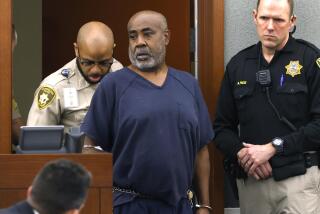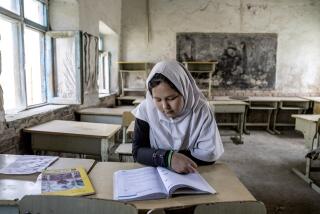Pakistanis struggle amid economic downturn
The Obama administration’s new strategy for Pakistan includes a pledge to triple the money spent on economic development for the shaky country. But down on street level, some Pakistanis question the effectiveness of pouring more money into a leaky economy without fundamental reform.
“Pakistan got a lot of loans from the World Bank and IMF already, but it’s all been wasted” by corrupt or inept officials, fabric store owner Akhlaq Abbas said, scratching his grizzled chin. “Donors should be careful giving money to Pakistan. Proper use is not happening.”
The aid, however, keeps flowing. The International Monetary Fund in November approved a $7.6-billion loan to Pakistan. Last week, the World Bank announced a $500-million interest-free loan for anti-poverty efforts. The Obama administration plan, if approved, would provide $1.5 billion annually in non-military aid over five years.
Abbas said that over the last decade Pakistan has seen many billions of dollars flow in from foreign aid organizations, yet there’s little to show for it other than “huge debts, constant power cuts and, every few months, more price increases.”
The 61-year-old said his life is getting tougher every day. “I’ve now resorted to living off the savings I’ve accumulated over the last six decades,” he said. Customers who used to come in droves to buy luxurious fabrics for curtains and slipcovers now buy only the inexpensive cloth they absolutely need.
An economist with the Quaid-i-Azam University in Islamabad, the capital, who asked not to be identified because he wasn’t authorized to speak to the foreign press, said, “Rather than taking more loans, we should cut nonessential costs, like ministers’ salaries.”
Inflation has exceeded 20%, while prices for staples such as onions have risen 253% since July 2008 and sugar by 66%. Even worse for some is the uneven nature of the increases.
Umair Qureshi, an Islamabad butcher, guarded his cash box from atop a 4-foot platform as an assistant nearby waved away flies trying to land on two dozen goat heads.
Even as his costs have risen to $57 per goat from $38 a few months back, he said, the law forbids him to raise prices as policymakers try to stem social unrest. The result: His profit margin has been sliced as his sales dropped by half, leaving his family with barely enough to survive on. “Things really aren’t going well,” he said with a sigh.
People offer different explanations for why things are so bad. Some blame policies that result in goods being exported rather than distributed among struggling Pakistanis.
Others point a finger at the rich and the corrupt who they say send their money and families overseas in tough times while the poor are left trying to make an honest rupee.
Attacks and suicide bombings by militants put a further chill on economic activity, discouraging people from going out in public. On Friday, at least 50 people were killed in a suicide bombing at a mosque near the Afghan border.
Mian Azhar Saeed, a real estate salesman in the city of Lahore, whose office was shot up during an attack on the Sri Lankan cricket team early this month, said he used to go out on Saturday nights to cafes to chat with friends, enjoy a walk and shop with his wife. Now he scurries between work and home, hunkered down, afraid to spend money. Extend that across Pakistan, he said, and you can see why people are hurting.
Arif Raj Saraj, 41, of Lahore who manages a restaurant with an American cowboy theme, said he was worried about the dearth of customers and the site’s potential to become a target. “I’ve got 40 people working for me, all of whom need to earn a living,” he said. “I’m trying to pray for Pakistan and my people.”
The turmoil of the last several months has left some longing for the return of Gen. Pervez Musharraf, the authoritarian strongman who remained in power for more than eight years after staging a bloodless coup in 1999.
“I hope he comes back,” said Mujeeb Zahur, general manager of Touchstone, a call center in Islamabad. “No matter who or what he did in other areas, he seemed to do things for us that made sense.” Unlike the current leadership, some said, Musharraf appreciated business, allocated jobs on merit and presided over a less tumultuous period.
Not everyone is suffering. Because Pakistan’s economy is relatively closed, its banks heavily regulated and key industries closely controlled, it has been less vulnerable than other countries to the fallout of the subprime meltdown and other problems.
“Since it never did that well to begin with, there was less room to fall,” Zahur said. “And there are still a lot of families with money. Many industries like sugar and flour mills with government guarantees are still in a good position.”
Faisal Subhani, 45, owner of an electronics shop in Islamabad, said lower prices have bolstered his sales, with TVs, microwaves and DVD players selling well.
“People still need things,” he said.
As he spoke, a 30-year-old homemaker who gave only her first name, Nasim, walked out of his shop with a new flat-screen TV. “The overall economy isn’t great,” she said, “but we’re buying because we still have to live on this planet.”
But that seemed to be a minority view. “Our politicians only think of their own interests,” Saeed, the real estate salesman, said. “We really need some economic and political stability.”
--
More to Read
Start your day right
Sign up for Essential California for news, features and recommendations from the L.A. Times and beyond in your inbox six days a week.
You may occasionally receive promotional content from the Los Angeles Times.






